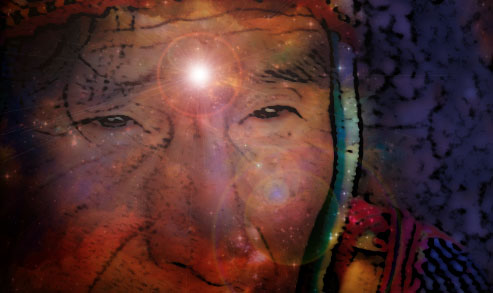 Vision is a rather miraculous process that required millions of years of evolution to perfect. For many complex life forms—from grasshoppers to whales—it is the primary means of perception. Human vision relies on three components: the eyes, the optic nerve, and the visual cortex in the brain. The eyes convert light into electrical signals. These signals are carried by the optic nerve as a stream of electrons into the visual cortex (much like the television cable carries a signal to the TV set). The visual cortex or “screening room” in the brain, which is located behind the ears in the back of the head, then generates an image. All seeing, in effect, happens inside the head, although it appears that we see the world outside.
Vision is a rather miraculous process that required millions of years of evolution to perfect. For many complex life forms—from grasshoppers to whales—it is the primary means of perception. Human vision relies on three components: the eyes, the optic nerve, and the visual cortex in the brain. The eyes convert light into electrical signals. These signals are carried by the optic nerve as a stream of electrons into the visual cortex (much like the television cable carries a signal to the TV set). The visual cortex or “screening room” in the brain, which is located behind the ears in the back of the head, then generates an image. All seeing, in effect, happens inside the head, although it appears that we see the world outside.
When your physician checks your heart, she might perform an electrocardiogram. The sensors attached to your chest send a signal through a wire to a chart recorder that shows the blips of your heartbeat. If she wanted to check the temperature of her wine cellar, she could simply attach a thermometer to the wall but still use the same recorder. With the right sensor and cable, the chart recorder can measure any type of activity—from heartbeats to earthquakes. With ordinary seeing, the eyes are the sensors, the optic nerve is the cable, and the visual cortex is the recorder. To see into the world of energy, we have to disengage the sensors (the eyes) and the cable (optic nerve), but we want to keep the recorder, the visual cortex. The sole function of the recorder is to translate a signal into an image. This is why I call it the “screening room.”
The eyes are of little use for perceiving the invisible world of energy and spirit. Our retinas register only a narrow band in the electromagnetic spectrum; they do not register infrared or ultraviolet, for example, which the skin readily responds to. The optic nerve does not help either, because it is just a one-way cable that only connects the eyes to the screening room. The screening room, however, is an extraordinary structure. The visual cortex is able to translate energy (electrical impulses from the optic nerve) into living images. Thus, the mechanism for seeing energy is already in place: To perceive the Luminous Energy Field and the stories encoded within it, we need only change the source of the signal and allow the visual cortex to do what nature designed it to do—create images.
We have the sensors we need to develop the shaman’s way of seeing—they are the sixth chakra (the mythic “third eye” in the center of the forehead) and the fourth chakra, the heart. By connecting the heart chakra and the third eye to the visual cortex, we can see with the eyes of the mind and the heart. The task is getting a “cable” from these chakras to the screening room in the back of the head.
As an anatomy student, I learned that the human brain is hardwired. After the neural pathways in the brain are established, it is very difficult to change them. It is impossible to lay new neurological tracks to the visual cortex. If the human optic nerve is severed, a person is blinded and does not recover vision. Yet he still dreams in full color and imagery. Thus, to see with the eyes of the heart, we must create an extracerebral network, outside the brain. The shaman’s rites for seeing can lay extracerebral pathways that connect the heart and the third eye to the screening room of the visual cortex to achieve multisensorial images of the luminous world.
For the first few years of our life, we have ten times more synaptic connections in the brain than when we become adults. Synapses are like branches that extend from nerve cells, forking in multiple directions, until they find another branch to link with. Synaptic connections are the pathways through which we process information. While we were toddlers we might have discovered six different ways to approach a water glass and pick it up. Eventually, as we learned the way that was best for us, left- or right-handedness, the other pathways shriveled and died.
Synapses connect one brain cell to another, and can be compared to trails in a forest. Some trails are very direct and lead over grassland to the river. Other paths are more circuitous, through patches of poplars and elms, but eventually leading to the same river. Once we have drawn our maps of reality, 90 percent of our synaptic connections die. We become familiar with only one way to get to the river. The other routes are erased.
In our culture, mapping the landscape of the invisible world is not a priority. This spiritual landscape is not even acknowledged as real. Westerners have not developed the neural pathways to sense energy. So we must lay these pathways outside the brain. You can think of them as meridians of golden light routed along the outside of the head, connecting the third eye and the heart to the visual cortex. These pathways relay multimodal sensory data-images, textures, sounds, tastes, feelings, and fragrances.
Next week: Learn how to connect with your inner perception.
.








 Vision is a rather miraculous process that required millions of years of evolution to perfect. For many complex life forms—from grasshoppers to whales—it is the primary means of perception. Human vision relies on three components: the eyes, the optic nerve, and the visual cortex in the brain. The eyes convert light into electrical signals. These signals are carried by the optic nerve as a stream of electrons into the visual cortex (much like the television cable carries a signal to the TV set). The visual cortex or “screening room” in the brain, which is located behind the ears in the back of the head, then generates an image. All seeing, in effect, happens inside the head, although it appears that we see the world outside.
Vision is a rather miraculous process that required millions of years of evolution to perfect. For many complex life forms—from grasshoppers to whales—it is the primary means of perception. Human vision relies on three components: the eyes, the optic nerve, and the visual cortex in the brain. The eyes convert light into electrical signals. These signals are carried by the optic nerve as a stream of electrons into the visual cortex (much like the television cable carries a signal to the TV set). The visual cortex or “screening room” in the brain, which is located behind the ears in the back of the head, then generates an image. All seeing, in effect, happens inside the head, although it appears that we see the world outside.